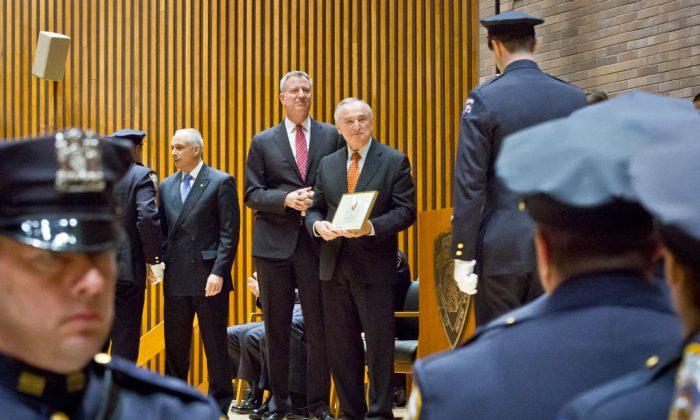NEW YORK—Even as New York’s police department takes heat for its tactics in the outrage over the Eric Garner chokehold case, year-end crime statistics show two clear trends: low-level arrests are holding steady and overall crime continues to fall.
The numbers could be seen as an affirmation of Police Commissioner William Bratton’s signature “broken windows” tactic, the idea that enforcing smaller crimes like fare beating and public drunkenness help prevent bigger crimes.
It has come under intense scrutiny since the July in-custody death of Garner, who was stopped for the minor offense of selling loose, untaxed cigarettes.
Historic drops in crime that continue today “didn’t just happen,” Bratton wrote in a recent op-ed piece defending the strategy he pioneered as commissioner in the 1990s. “They resulted from thousands of police interventions on the street, which restored order and civility across the five boroughs.”
Even NYPD arrests for selling untaxed cigarettes are slightly up from last year. Numbers from the state Department of Criminal Justice Services show there were 515 misdemeanor arrests for the offense through mid-November, compared to 463 over the same period a year ago. And the pace of those arrests continued unabated even in the weeks since Garner’s death.
Overall misdemeanor arrests are on track to be about the same as last year, when there were 227,380, most for drug offenses at 58,714. Through October this year, there have been 194,844 arrests, including 51,783 drug busts.
Through Dec. 14, overall serious crime had declined 4.7 percent compared to the same period last year, continuing a downward trend that started in the mid-1990s. The murder total stood at 305, a 5.3 percent drop. Reports of robberies were down 14 percent and those of felony assaults dipped about 1 percent.
“Because of the broken windows approach, we are the safest we’ve ever been,” Mayor Bill de Blasio said Friday after attending an NYPD promotions ceremony. “I lived through the 1980s and early ‘90s in this city. I don’t want to go back there. I don’t think anyone wants to go back there.”
Criticism
The decreases come at a time when the NYPD has dramatically scaled back its highly disputed strategy of stop and frisk. A federal judge ruled last year the tactic unfairly targeted minorities. The total stops peaked at an annual high of nearly 700,000 in 2011 and are expected to be less than 50,000 this year.
But with stop-and-frisk waning, critics now question broken windows.
To some, stop-and-frisk and broken windows “are the same thing with a different name,” said Deborah Wright, president of the Association of Legal Aid Attorneys.
Another critic, City University of New York School of Law professor Steve Zeidman, calls broken windows an outdated and flawed theory. The NYPD takes credit for the declines in crime each year even though larger factors like an aging population play a more significant role, he said.
“Would crime still go down if you stopped arresting people for loose cigarettes? Undeniably yes,” he said.
The tactic was one of the reasons officers were at the corner store on Staten Island where Garner died. In an episode captured on video, officer Daniel Pantaleo wraps his arm around Garner and wrestles him to the ground. He died at a hospital after his cries of “I can’t breathe” went unaided.
A grand jury decided not to indict the officer, prompting mass protests and a public war of words between the mayor and head of the police officer’s union, who says the mayor is throwing cops “under the bus.”
Zeidman argues that any strategy that unnecessarily increases contact between police and civilians is a threat to community relations.
“The more you increase interactions, the more you increase the likelihood that something can go wrong,” he said. “I really thought the Eric Garner case would be the tipping point that would put an end to it.”
Most days in criminal court in Brooklyn there’s a parade of arrestees “where the only allegation is that they walked through subway cars and because they didn’t have ID on them, they get put in the system,” said a public defender, Elena Roberts, who participated in a protest last week. “That doesn’t really seem right to us.”
The suspected offenders “are disproportionately minority men,” Roberts added. “I know as a white woman, I’m afforded a certain privilege in my life and my activities that would never put me at risk for even being questioned for something so minor.”
From the Associated Press






